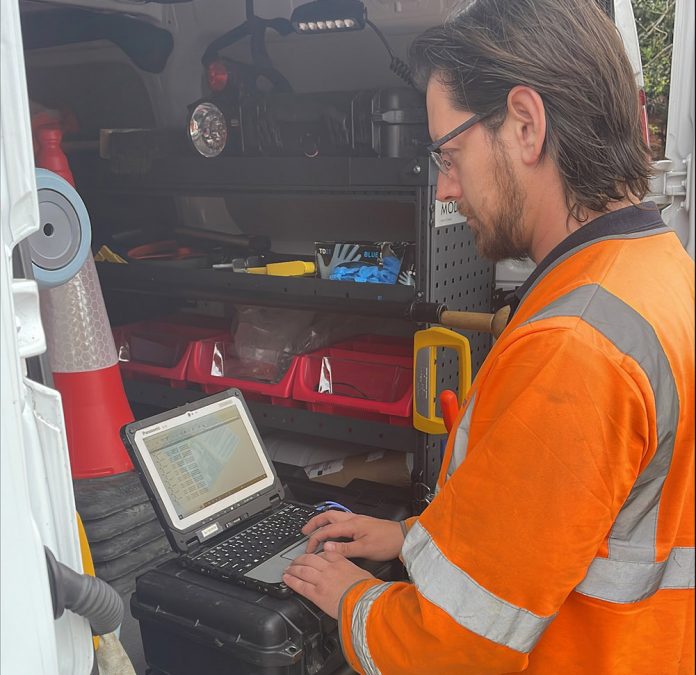Affinity Water have scored the best leakage results of any UK water company in 2023. James Curtis, Head of Leakage, explains how they did it.
The UK’s biggest water-only supplier have beaten their leakage target for 2022/23, reducing leakage by 15.8% against a target of 14%.
Faced with one of the industry’s toughest leakage reduction targets, Affinity are now down to their lowest ever leakage levels.
Detection and repair rates are quicker than ever, despite last year’s extreme weather – putting them in sight of their long-term aim to reduce leakage by 50% by 2050.
James says, “Obviously we are very, very pleased. The first two years of the AMP were difficult, and we needed to recalibrate to achieve our target.”
Back on track
“We are now back on track and confident we’ll achieve the full 20% target across the five-year period.”
He concedes that failing to reach initial targets was a huge wake-up call but “we were determined to meet our customer commitments, even in the harshest conditions.
“Basically, we had to step back and look at every element of our process again. Everyone across the business, from the contact centre and finance to the leakage department, played a part in helping deliver a better, more cost-efficient and effective leakage service.
“Getting that message across loud and clear broke down the silos and achieved our goals.”
James admits the last 12 months were very difficult, with a significant increase in bursts and leaks. “Climate change is putting significant pressure on our supply area in terms of the environment and water resources.”
“We used to see a traditional pattern of cold winter snaps, pipe bursts and fixes.
“But the extremes of record-breaking heat and below zero temperatures are causing much more ground movement. The summer was particularly challenging: the network was operating at record levels to keep up with demand, but we stuck to our guns.”
Prevention is the cure
The PALM approach to leakage management – prevention, awareness, locate and mend – is central to Affinity’s continual improvement strategy.
“The more we can do to prevent, the better we’ll do on leakage. We’ve introduced additional pressure management to help lengthen asset life and stop leaks.
“We also need to design leakage out of new networks so we’re not banking up problems for the future.
Improved awareness of what is leakage and what is consumption, and where that leakage is, allows us to reduce the run times of leaks, so a lot of focus has gone into making best use of available data.”
“Plus, the leakage reductions committed to this AMP has led to some great innovations in locating leaks. AI and technology are vastly improving our efficiencies, working practices and repair times all the time.
Satellite technology and acoustic logging are other key assets for Affinity, but James adds, “Technology is a much better listening device than the human ear…. then again, the grand old listening stick is still great for a final check!
“We can’t be everywhere all at once and so we still rely on the conscientious nature of our customers to report a good proportion of leaks. With over 3 million people in our area of supply, we potentially have 3 million leak detectors out there!
Over the past two years Affinity has also increased its support for repairing leaks on customer’s supply pipes.
“Our work is all about building trust. Achieving our targets gives our customers confidence in what we’re doing. So, when we ask them to save water, they know we’re doing our bit too.” And over 240,000 customers have so far signed up to Affinity’s Save Our Streams for free water-saving devices, tailored water-saving advice and free home water efficiency checks.
Future plans
Affinity aims to beat their leakage target again this year, ultimately following up on their 2015 – 2020 success with the largest reductions in leakage of all UK water companies.
James says, “We’re looking at extensive network calming for better management of pressure variations, and we also will need to put extra boots on the ground.
“Nine out of ten of our new apprentices are still with us as full-time leak detectors, and we aim to recruit more very soon.”
Longer term, James believes climate change remains the biggest challenge for leakage. “We have seen a move from the traditional leakage breakout profiles through cold weather impacts to more summer hot weather impact due to increases in ground movement. In recent years we have seen that summer leakage breakout is becoming just as significant as the winter breakout.”
The move from ferrous materials to plastics will also prove challenging for companies in the future.
“Our new pipes are plastic and don’t transmit acoustics very well, so different technologies are urgently needed to detect leaks on those pipes.”
Affinity’s challenges aren’t unique among the water utilities, making collaboration another major factor. “We’ve got a common goal, we all want to move forward together.”




